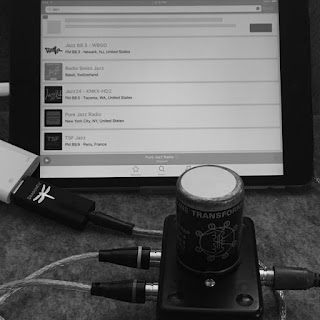Showing posts with label Digital Audio. Show all posts
Showing posts with label Digital Audio. Show all posts
Saturday, March 22, 2025
S.M.S.L PL100 CD player
It's been almost two months since I uploaded this video on my YouTube channel. So far, the PL100 CD player has been performing flawlessly and I'm fairly confident to report my findings!
Thursday, February 8, 2024
Line Transformers for Digital Audio
 |
| Altec 15356 + UTC A20 |
While browsing at Books Kinokuniya in NYC in the 90's, this Noguchi ad from the November 1994 MJ Audio Technology issue inspired me to experiment with line transformers as digital sound enhancers. Since I was living on a post-grad assistantship budget back then, importing this pair from Japan was out of the question.
Friday, February 4, 2022
Sony PS1 + Magnavox/Philips NOS TDA1543 CDP Mod
A revival of interest in CDs is imminent, sparked by Pope Francis' recent visit to a mom and pop record store in Rome.😉
 |
| from djmag.com |
Tuesday, December 15, 2020
nos TDA1541 tube DAC
I've become cynical of the latest is best mentality because in my 30 years of searching for sound that pleases my ears, I've always gone back to move forward. From this experience, I've learned to use planned obsolescence to my advantage by investing in old school components that have achieved classic status.
There is a common denominator between the Philips TDA1541 DAC chip and the Western Electric 300B directly heated output triode vacuum tube. The former brought digital sound to everyone’s homes in the '80s, while the latter amplified talking pictures in movie theaters in the '30s. Both have also been rediscovered for their distinguished musical abilities.
This tubed TDA1541 sans oversampling multi-bit DAC evolved from my frustration with its bitstream and delta-sigma successors, revisiting and studying multi-bit CD players and DACs, performing Magnavox CDP + DAC mods, and other digital audio experiments.
Saturday, August 1, 2020
JVC CD Players from the Thrift Store
Since my last CD player upload, I've acquired these three JVC CD players. It is stacked from the bottom to the top sonically according to yours truly. 😎
Wednesday, April 1, 2020
The Good, the Bad and the Ugly TDA1543 NOS DACs
In spite of its humble origins, I praised the musical abilities of the Philips TDA1543 DAC chip found in late 80s to early 90s budget CD players. Below are two affordable (under $30) Non-OverSampling DAC boards I sampled that use this ubiquitous chip.
Friday, October 11, 2019
Saturday, August 3, 2019
Saturday, June 15, 2019
Thrift Store CD Players for Red Book Aficionados
 |
| Multi-bit CD players |
When I started using and hacking Dynakit tube equipment, they were about 25 years old on average. During that same time frame, I bought my first CD player which was fitted with the Philips cutting-edge TDA1541 16-bit DAC chip.
Wednesday, February 6, 2019
Sunday, January 20, 2019
Listening Room - Minimalist no more?
Among the audio systems of my friends, this is the only set up that has no LP playback ability. Neither does the owner have interest in DVD-A, SACD or a music server/streaming device - only16 bit linear PCM sampled at 44kHz red book mastered CDs, period!
Monday, August 27, 2018
Monday, July 16, 2018
Raspberry Pi 3B+
The FM tuner has been a de rigeur music source in my audio system. Between the dwindling quality of FM broadcasts and proliferation of internet radio and music streaming apps like Pandora, Spotify, Tidal etc., I had to jump the bandwagon with my first generation iPad mini.
Sunday, March 25, 2018
XtremPro X1 USB DAC
I was too wound up after playing a gig one winter Sunday evening. Watching episodes of the Grand Tour over a couple shots of Ballantine Scotch Whiskey was not enough to relax my mind. So I ended up "window" shopping on Amazon.
Friday, December 1, 2017
Line Transformers Redux + Art Dudley + AQ Dragonfly Black
My boring digital life
 |
| Tascam DA-P1 courtesy of pgr.tv |
Probably the most significant digital audio gear I ever owned was the Tascam DA-P1 DAT recorder. This machine recorded my recitals, chamber music performances and served as a back-up and playback deck for my CD projects from the mid 90s until the early 2000s. It was rendered obsolete when HD based recording became the industry standard.
Saturday, April 9, 2016
Stereo > Mono Line Level Mixer - ***Revised 4/12/21***
Mixing line level stereophonic signals into full dimensional monophonic ;)
Here's a DIY project for mono aficionados that's so basic, I should have uploaded it many years ago. But other things got in the way.
Just like an MC step-up, these are entirely passive devices.
Subscribe to:
Comments (Atom)











